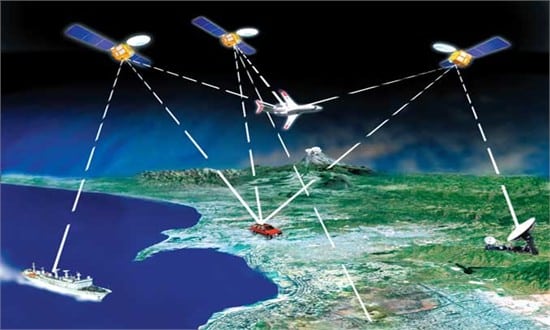
Back to selection

Supplier
China National Space Administration (CNSA)
BeiDou Navigation Satellite System
The BeiDou Navigation Satellite System (BDS) is a Chinese satellite navigation system that offers precise positioning, navigation, and timing services to users worldwide, regardless of weather conditions and at all times. BDS has found extensive applications in various sectors, including transportation, agriculture, forestry, fisheries, hydrological monitoring, meteorological forecasting, communication, power dispatching, disaster relief, and public security.
The BeiDou Navigation Satellite System (BDS) is operated by the China National Space Administration (CNSA), which is a governmental agency of the People’s Republic of China. CNSA is headquartered in Haidian, Beijing and is entrusted with the responsibility of overseeing civil space administration and international space cooperation. It was established in 1993 following the division of the Ministry of Aerospace Industry into CNSA and the China Aerospace Science and Technology Corporation (CASC).
The system is composed of two distinct satellite constellations. The initial version, known as the BeiDou Satellite Navigation Experimental System (BeiDou-1), consisted of three satellites and provided limited coverage and navigation services primarily for users in China and nearby regions starting from 2000. BeiDou-1 was retired by the end of 2012.


The second generation, officially known as the BeiDou Navigation Satellite System (BDS) or COMPASS (BeiDou-2), became operational in China in December 2011. Initially, it had a partial constellation of 10 satellites in orbit. Since December 2012, BDS has been offering services to customers in the Asia-Pacific region. Notably, within this region, BeiDou provides higher accuracy than GPS.
In 2015, China initiated the launch of the third-generation BeiDou system (BeiDou-3) with the objective of achieving global coverage. The first BDS-3 satellite was successfully launched on March 30th, 2015. Subsequently, on December 27th, 2018, the BeiDou Navigation Satellite System commenced providing global services. The final satellite of BDS-3, marking the 35th satellite, was launched into orbit on June 23rd, 2020. It was announced in 2016 that BeiDou-3 would attain millimeter-level accuracy with post-processing techniques.
On June 23rd, 2020, the most recent BeiDou satellite was launched, signifying the addition of the 55th satellite to the Beidou family. The third iteration of the Beidou Navigation Satellite System now offers comprehensive global coverage for both timing and navigation services, presenting an alternative to Russia’s GLONASS, the European Galileo positioning system operated by EUSPA, and the USSF GPS from the USA.
The BDS (BeiDou Navigation Satellite System) is structured into three primary segments: the space segment, the ground segment, and the user segment.
The space segment of BDS encompasses satellites positioned in different orbits: Geostationary Earth Orbit (GEO), Inclined Geo-Synchronous Orbit (IGSO), and Medium Earth Orbit (MEO).
The ground segment of BDS comprises multiple ground stations, including master control stations, time synchronization/uplink stations, monitoring stations, and facilities for the operation and management of inter-satellite links.
The user segment of BDS includes a variety of BDS basic products, systems, and services that are compatible with other navigation systems. This encompasses fundamental products such as chips, modules, and antennae, as well as terminals, application systems, and application services.
| Satellite | Orbit | Launch Date | Launcher | Launch Operator |
| BeiDou-1A | GEO 140° E | Oct 30th, 2000 | LM-3A | CGWIC China |
| BeiDou-1B | GEO 80° E | Dec 21st, 2000 | LM-3A | CGWIC China |
| BeiDou-1C | GEO 111° E | May 25th, 2003 | LM-3A | CGWIC China |
| BeiDou-1D | GEO 86° E | Feb 7th, 2007 | LM-3A | CGWIC China |
| Compass-M1 | MEO | Apr 13th, 2007 | LM-3A | CGWIC China |
| Compass-G2 | GEO drifting | Apr 14th, 2009 | LM-3C | CGWIC China |
| Compass-G1 | GEO 140° E | Jan 16th, 2010 | LM-3C | CGWIC China |
| Compass-G3 | GEO 80° E | June 2nd, 2010 | LM-3C | CGWIC China |
| Compass-IGSO1 | ISGO 118° E | July 31st, 2010 | LM-3A | CGWIC China |
| Compass-G4 | GEO 160° E | Oct 31st, 2010 | LM-3C | CGWIC China |
| Compass-IGSO2 | ISGO 118° E | Dec 17th, 2010 | LM-3A | CGWIC China |
| Compass-IGSO3 | ISGO 118° E | Apr 9th, 2011 | LM-3A | CGWIC China |
| Compass-IGSO4 | ISGO 95° E | July 26th, 2011 | LM-3A | CGWIC China |
| Compass-IGSO5 | ISGO 95° E | Dec 1st, 2011 | LM-3A | CGWIC China |
| Compass-G5 | GEO 59° E | Feb 24th, 2012 | LM-3C | CGWIC China |
| Compass-M3 | MEO | Apr 29th, 2012 | LM-3B | CGWIC China |
| Compass-M4 | MEO | Apr 29th, 2012 | LM-3B | CGWIC China |
| Compass-M5 | MEO | Sep 18th, 2012 | LM-3B | CGWIC China |
| Compass-M6 | MEO | Sep 18th, 2012 | LM-3B | CGWIC China |
| Compass-G6 | GEO 80° E | Oct 25th, 2012 | LM-3C | CGWIC China |
| BeiDou-3 I1-S | ISGO 95° E | Mar 30th, 2015 | LM-3B/YZ-1 | CGWIC China |
| BeiDou-3 M1-S | MEO | July 25th, 2015 | LM-3B/YZ-1 | CGWIC China |
| BeiDou-3 M2-S | MEO | July 25th, 2015 | LM-3B/YZ-1 | CGWIC China |
| BeiDou-3 I2-S | ISGO 95° E | Sep 29th, 2015 | LM-3B | CGWIC China |
| BeiDou-3 M3-S | MEO | Feb 1st, 2016 | LM-3B/YZ-1 | CGWIC China |
| Compass-IGSO6 | ISGO 95° E | Mar 29th, 2016 | LM-3A | CGWIC China |
| Compass-G7 | GEO 111° E | June 12th, 2016 | LM-3C | CGWIC China |
| BeiDou-3 M1 | MEO | Nov 5th, 2017 | LM-3B/YZ-1 | CGWIC China |
| BeiDou-3 M2 | MEO | Nov 5th, 2017 | LM-3B/YZ-1 | CGWIC China |
| BeiDou-3 M7 | MEO | Jan 11th, 2018 | LM-3B/YZ-1 | CGWIC China |
| BeiDou-3 M8 | MEO | Jan 11th, 2018 | LM-3B/YZ-1 | CGWIC China |
| BeiDou-3 M3 | MEO | Feb 12th, 2018 | LM-3B/YZ-1 | CGWIC China |
| BeiDou-3 M4 | MEO | Feb 12th, 2018 | LM-3B/YZ-1 | CGWIC China |
| BeiDou-3 M9 | MEO | Mar 29th, 2018 | LM-3B/YZ-1 | CGWIC China |
| BeiDou-3 M10 | MEO | Mar 29th, 2018 | LM-3B/YZ-1 | CGWIC China |
| Compass-IGSO7 | ISGO 95° E | July 9th, 2018 | LM-3A | CGWIC China |
| BeiDou-3 M5 | MEO | July 29th, 2018 | LM-3B/YZ-1 | CGWIC China |
| BeiDou-3 M6 | MEO | July 29th, 2018 | LM-3B/YZ-1 | CGWIC China |
| BeiDou-3 M11 | MEO | Aug 24th, 2018 | LM-3B/YZ-1 | CGWIC China |
| BeiDou-3 M12 | MEO | Aug 24th, 2018 | LM-3B/YZ-1 | CGWIC China |
| BeiDou-3 M13 | MEO | Sep 19th, 2018 | LM-3B/YZ-1 | CGWIC China |
| BeiDou-3 M14 | MEO | Sep 19th, 2018 | LM-3B/YZ-1 | CGWIC China |
| BeiDou-3 M15 | MEO | Oct 15th, 2018 | LM-3B/YZ-1 | CGWIC China |
| BeiDou-3 M16 | MEO | Oct 15th, 2018 | LM-3B/YZ-1 | CGWIC China |
| BeiDou-3 G1 | GSO 144° E | Nov 1st, 2018 | LM-3B/E | CGWIC China |
| BeiDou-3 M17 | MEO | Nov 18th, 2018 | LM-3B/YZ-1 | CGWIC China |
| BeiDou-3 M18 | MEO | Nov 18th, 2018 | LM-3B/YZ-1 | CGWIC China |
| BeiDou-3 I1 | ISGO 55° E | Apr 20th, 2019 | LM-3B/E | CGWIC China |
| Compass-G8 | GSO | May 17th, 2019 | LM-3C | CGWIC China |
| BeiDou-3 I2 | ISGO 55° E | June 24th, 2019 | LM-3B/E | CGWIC China |
| BeiDou-3 M23 | MEO | Sep 22nd, 2019 | LM-3B/YZ-1 | CGWIC China |
| BeiDou-3 M24 | MEO | Sep 22nd, 2019 | LM-3B/YZ-1 | CGWIC China |
| BeiDou-3 I3 | ISGO 55° E | Nov 4th, 2019 | LM-3B/E | CGWIC China |
| BeiDou-3 M21 | MEO | Nov 23rd, 2019 | LM-3B/YZ-1 | CGWIC China |
| BeiDou-3 M22 | MEO | Nov 23rd, 2019 | LM-3B/YZ-1 | CGWIC China |
| BeiDou-3 M19 | MEO | Dec 16th, 2019 | LM-3B/YZ-1 | CGWIC China |
| BeiDou-3 M20 | MEO | Dec 16th, 2019 | LM-3B/YZ-1 | CGWIC China |
| BeiDou-3 G2 | GSO | Mar 9th, 2020 | LM-3B/E | CGWIC China |
| BeiDou-3 G3 | GSO | June 23rd, 2020 | LM-3B/E | CGWIC China |
MEO: Medium Earth Orbit
ISGO: Inclined Geosynchronous Orbit
GSO: Geosynchronous Orbit
China National Space Administration (CNSA)
The China National Space Administration (CNSA) is a government agency based in Haidian, Beijing, within the People’s Republic of China. It assumes the role of overseeing civil space administration and fostering international cooperation in space-related endeavors. Among its tasks is the coordination of foreign aerospace collaborations. The CNSA operates as an administrative arm under the jurisdiction of the Ministry of Industry and Information Technology.
Established in 1993, the China National Space Administration (CNSA) has achieved notable milestones in China’s space exploration history, despite its relatively brief existence.
These achievements include pioneering the first-ever landing on the far side of the Moon with the Chang’e 4 mission, successfully bringing lunar material back to Earth through the Chang’e 5 mission, and becoming the second entity worldwide to accomplish a successful rover landing on Mars with the Tianwen-1 mission.
It’s important to note that while the CNSA governs civil space activities, it does not directly execute specific space programs. Instead, the China Aerospace Science and Technology Corporation (CASC) handles the execution of China’s state space programs. Additionally, the China Manned Space Program is operated by the China Manned Space Agency, independent of the CNSA.
Historical Background
The CNSA was established in 1993 as part of the division of the Ministry of Aerospace Industry into two distinct entities: the CNSA itself, responsible for policy formulation, and the China Aerospace Science and Technology Corporation (CASC), tasked with program execution. Initially, these two agencies functioned somewhat cohesively, sharing personnel and management.
In a major restructuring effort in 1998, CASC underwent further division into multiple smaller state-owned companies. This restructuring aimed to create a system resembling the Western defense procurement model, where government agencies set operational policies and subsequently outsourced their operational requirements to government-owned but independently managed entities.
Since the enactment of the Wolf Amendment in 2011, NASA has been compelled by Congress to maintain an exclusion policy with regards to CNSA collaborations. However, these restrictions have occasionally been overcome through periodic initiatives and negotiations.
All trademarks, logos and images mentioned and showed on this page are property of their respective owners.
Resources
www.cnsa.gov.cn
www.gps.gov
www.euspa.europe.eu
www.glosnass-iac.ru
www.beidou.gov.cn
www.isro.gov.in
www.qzss.go.jp
www.wikipedia.org

Supplier
China National Space Administration (CNSA)
Rideshare missions by China National Space Administration (CNSA)
| Rideshare Mission | Launch date | Launch vehicle | Spacecraft launched | Orbit |
| CASC CZ-3B Y49 / Beidou-33 – 34 | 29 July 2018 | Long March 3B (CZ-3B) | 2 | MEO |

Supplier
China National Space Administration (CNSA)
Dedicated missions by China National Space Administration (CNSA)
| Dedicated Mission | Launch date | Launch vehicle | Orbit |
| CASC CZ-3B Y33 / Beidou-20 (BD-3 I2-S) | 29 September 2015 | Long March 3B (CZ-3B) | GEO |